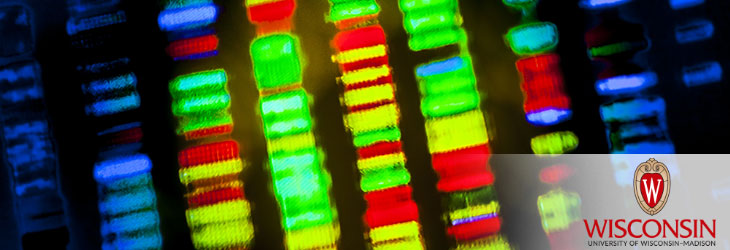Diagnostics & Biomarkers

High-Throughput Microfluidics Platform Enables Scalable Single-Cell Nucleic Acid Biomarker Detection
WARF: P180094US02
Inventors: Philip Romero, Leland Hyman
The Wisconsin Alumni Research Foundation is seeking commercial partners interested in developing a single-cell nucleic acid biomarker detection device with 10,000-fold higher throughput than currently available technologies. Ultrahigh-throughput microfluidics enable single-cell nucleic acid detection at a speed scalable for routine cancer treatment monitoring, in addition to infection detection and diagnostics.
Overview
Detection of genetic aberrations using nucleic acids as biomarkers can be a powerful strategy for disease diagnosis and progression monitoring; however, the high heterogeneity of cells within a patient sample can lead to unreliable conclusions when detecting nucleic acids from bulk cell samples.
Single-cell analysis avoids this vulnerability by monitoring individual cell types for biomarkers, offering more refined selectivity and generating more reliable evidence for drawing diagnostic conclusions. However, the scalability of single-cell methods is often limited by throughput and the benefits of single-cell analysis cannot be realized in a real-world setting with commercially available low-throughput instruments.
Single-cell analysis avoids this vulnerability by monitoring individual cell types for biomarkers, offering more refined selectivity and generating more reliable evidence for drawing diagnostic conclusions. However, the scalability of single-cell methods is often limited by throughput and the benefits of single-cell analysis cannot be realized in a real-world setting with commercially available low-throughput instruments.
The Invention
UW-Madison researchers have developed a platform to enable high-throughput single-cell nucleic acid detection. The invention integrates multiple single-cell and microfluidic methodologies in the first completely automated high-throughput single-cell assay system capable of performing up to one million multiplexed single-cell assays per hour.
Using microfluidic droplet generators, individual cells can be encapsulated in droplets with lysis and amplification reagents. In-droplet amplification of nucleic acids is then performed using reverse transcription-loop-mediated isothermal amplification (RT-LAMP), which was shown to be an optimal amplification strategy due to its robust performance at high cell lysate concentrations. This robustness allows a simplified microfluidic workflow without any additional droplet manipulation steps. Following amplification, nucleic acid logic circuits can be implemented in multiple configurations using YES, NOT, OR, AND and AND-NOT operations for targeting nucleic acids in specific cell types, further improving the selectivity of the platform.
Using microfluidic droplet generators, individual cells can be encapsulated in droplets with lysis and amplification reagents. In-droplet amplification of nucleic acids is then performed using reverse transcription-loop-mediated isothermal amplification (RT-LAMP), which was shown to be an optimal amplification strategy due to its robust performance at high cell lysate concentrations. This robustness allows a simplified microfluidic workflow without any additional droplet manipulation steps. Following amplification, nucleic acid logic circuits can be implemented in multiple configurations using YES, NOT, OR, AND and AND-NOT operations for targeting nucleic acids in specific cell types, further improving the selectivity of the platform.
Applications
- Screening for circulating tumor cells (CTCs) and other low abundance cell types
- Monitoring cancer treatment efficacy via nucleic acid biomarkers
- Detecting and diagnosing low-abundance infections
Key Benefits
- A 10,000-fold increase in throughput as compared to commercially available technologies
- Offers a completely automated solution to single-cell nucleic acid profiling
- Highly adaptable platform for detection of many different nucleic acid targets
Stage of Development
The development of this technology was supported by WARF Accelerator. WARF Accelerator selects WARF's most commercially promising technologies and provides expert assistance and funding to enable achievement of commercially significant milestones.
Additional Information
For More Information About the Inventors
For current licensing status, please contact Jennifer Gottwald at [javascript protected email address] or 608-960-9854